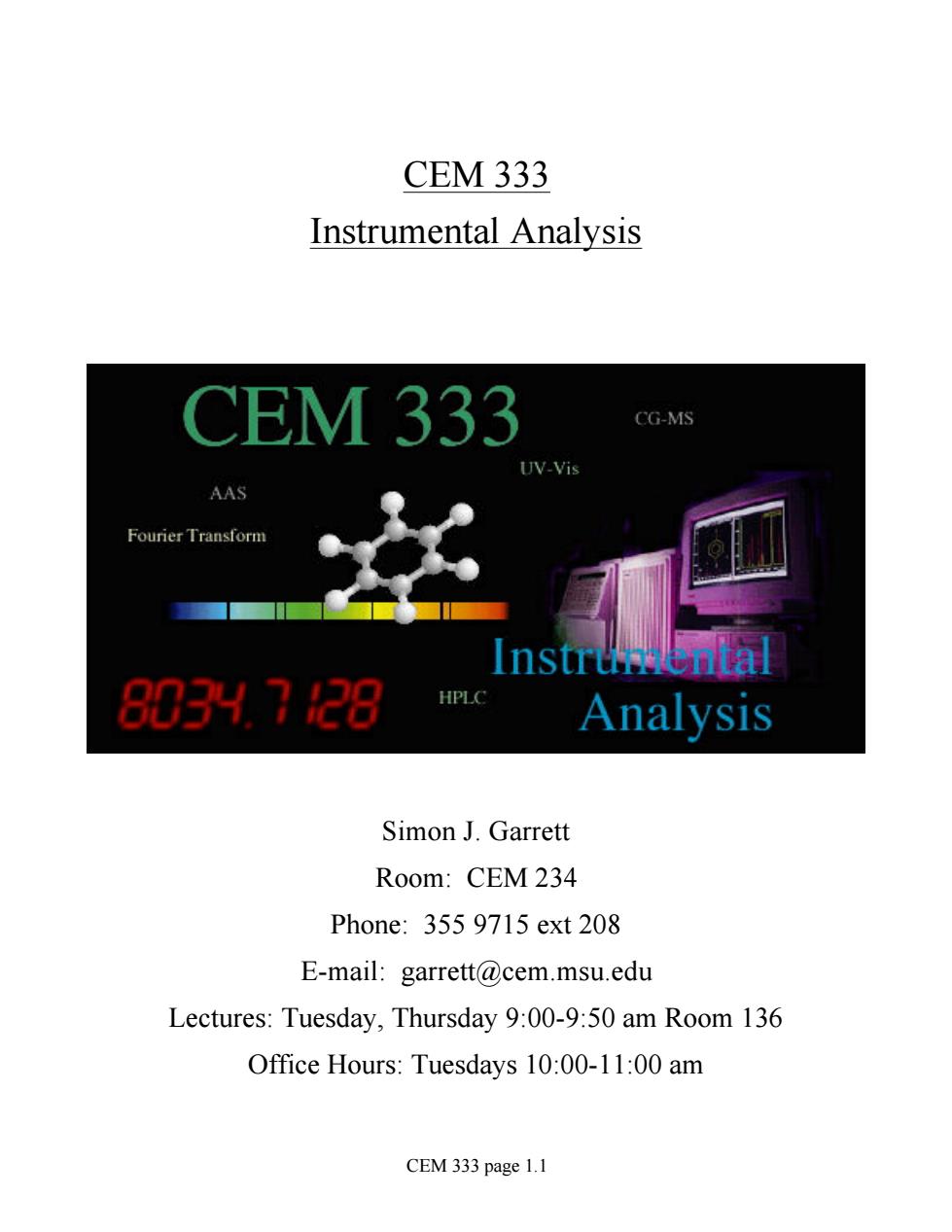
CEM 333 Instrumental Analysis CEM 333 CG-MS UV-Vis AAS Fourier Transform Instruental 803H.728 Analysis Simon J.Garrett Room:CEM 234 Phone:355 9715 ext 208 E-mail:garrett@cem.msu.edu Lectures:Tuesday,Thursday 9:00-9:50 am Room 136 Office Hours:Tuesdays 10:00-11:00 am CEM 333 page 1.1
CEM 333 Instrumental Analysis Simon J. Garrett Room: CEM 234 Phone: 355 9715 ext 208 E-mail: garrett@cem.msu.edu Lectures: Tuesday, Thursday 9:00-9:50 am Room 136 Office Hours: Tuesdays 10:00-11:00 am CEM 333 page 1.1
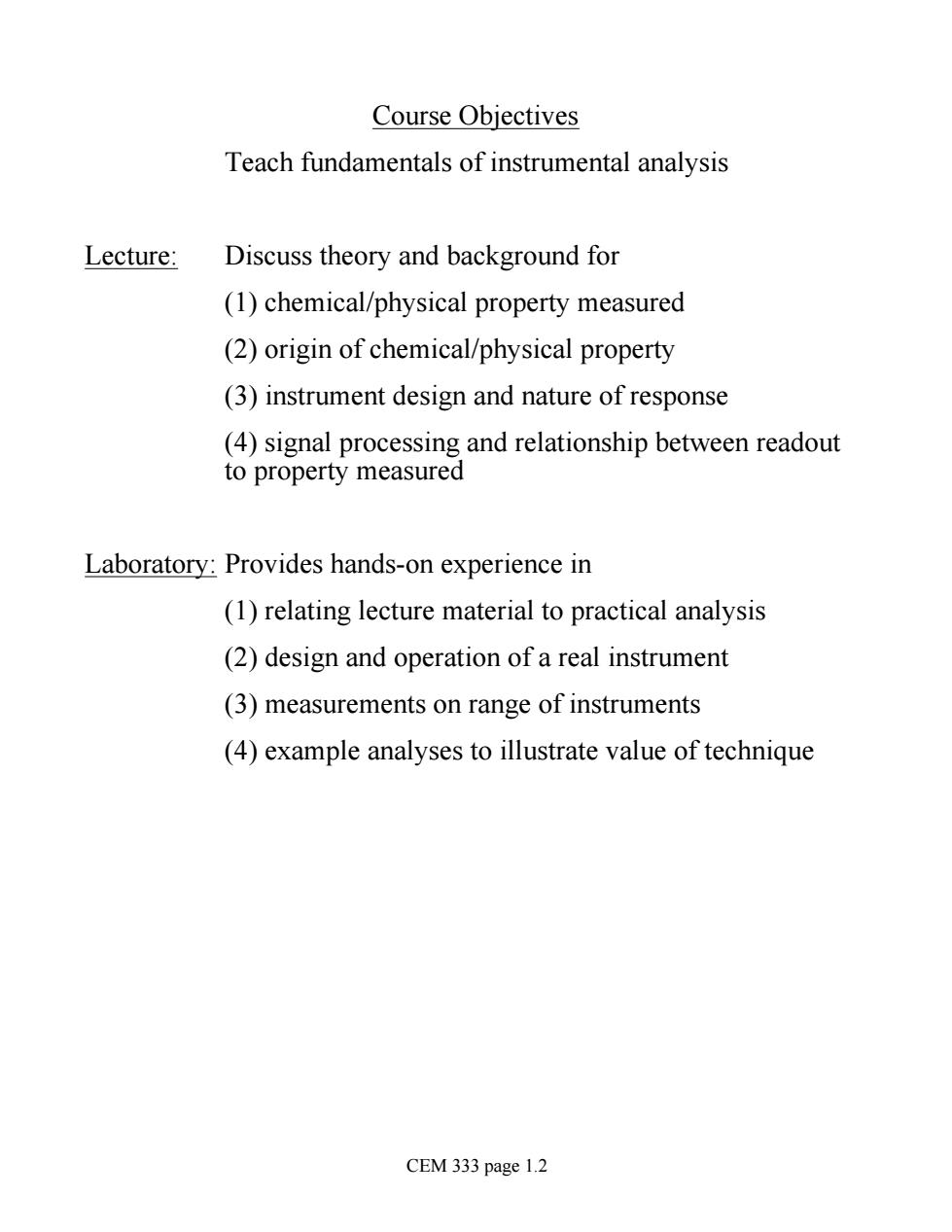
Course Objectives Teach fundamentals of instrumental analysis Lecture: Discuss theory and background for (1)chemical/physical property measured (2)origin of chemical/physical property (3)instrument design and nature of response (4)signal processing and relationship between readout to property measured Laboratory:Provides hands-on experience in (1)relating lecture material to practical analysis (2)design and operation of a real instrument (3)measurements on range of instruments (4)example analyses to illustrate value of technique CEM 333 page 1.2
Course Objectives Teach fundamentals of instrumental analysis Lecture: Discuss theory and background for (1) chemical/physical property measured (2) origin of chemical/physical property (3) instrument design and nature of response (4) signal processing and relationship between readout to property measured Laboratory: Provides hands-on experience in (1) relating lecture material to practical analysis (2) design and operation of a real instrument (3) measurements on range of instruments (4) example analyses to illustrate value of technique CEM 333 page 1.2
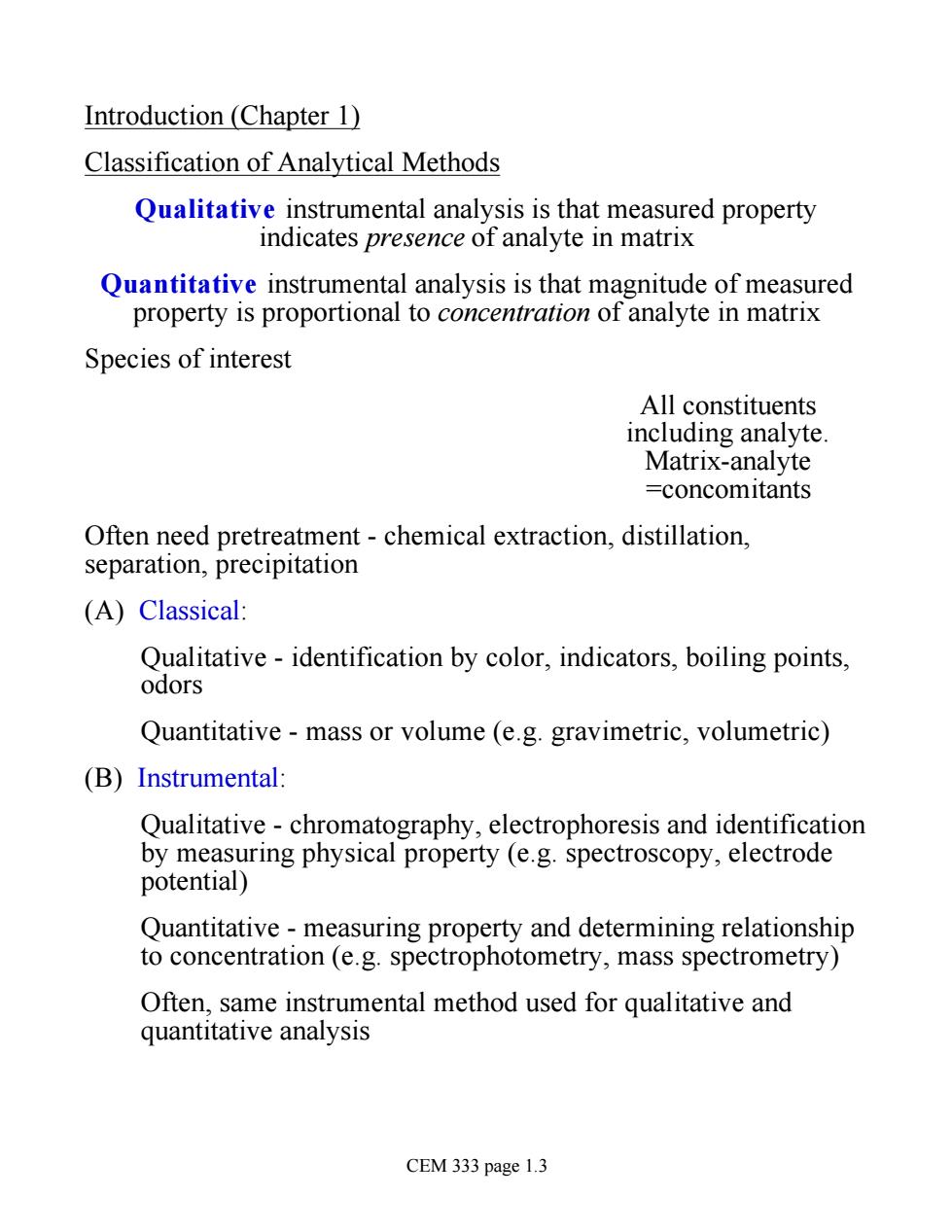
Introduction (Chapter 1) Classification of Analytical Methods Qualitative instrumental analysis is that measured property indicates presence of analyte in matrix Quantitative instrumental analysis is that magnitude of measured property is proportional to concentration of analyte in matrix Species of interest All constituents including analyte Matrix-analyte =concomitants Often need pretreatment-chemical extraction,distillation, separation,precipitation (A)Classical: Qualitative-identification by color,indicators,boiling points, odors Quantitative -mass or volume (e.g.gravimetric,volumetric) (B)Instrumental Qualitative -chromatography,electrophoresis and identification by measuring physical property (e.g.spectroscopy,electrode potential) Quantitative-measuring property and determining relationship to concentration(e.g.spectrophotometry,mass spectrometry) Often,same instrumental method used for qualitative and quantitative analysis CEM 333 page 1.3
Introduction (Chapter 1) Classification of Analytical Methods Qualitative instrumental analysis is that measured property indicates presence of analyte in matrix Quantitative instrumental analysis is that magnitude of measured property is proportional to concentration of analyte in matrix Species of interest All constituents including analyte. Matrix-analyte =concomitants Often need pretreatment - chemical extraction, distillation, separation, precipitation (A) Classical: Qualitative - identification by color, indicators, boiling points, odors Quantitative - mass or volume (e.g. gravimetric, volumetric) (B) Instrumental: Qualitative - chromatography, electrophoresis and identification by measuring physical property (e.g. spectroscopy, electrode potential) Quantitative - measuring property and determining relationship to concentration (e.g. spectrophotometry, mass spectrometry) Often, same instrumental method used for qualitative and quantitative analysis CEM 333 page 1.3
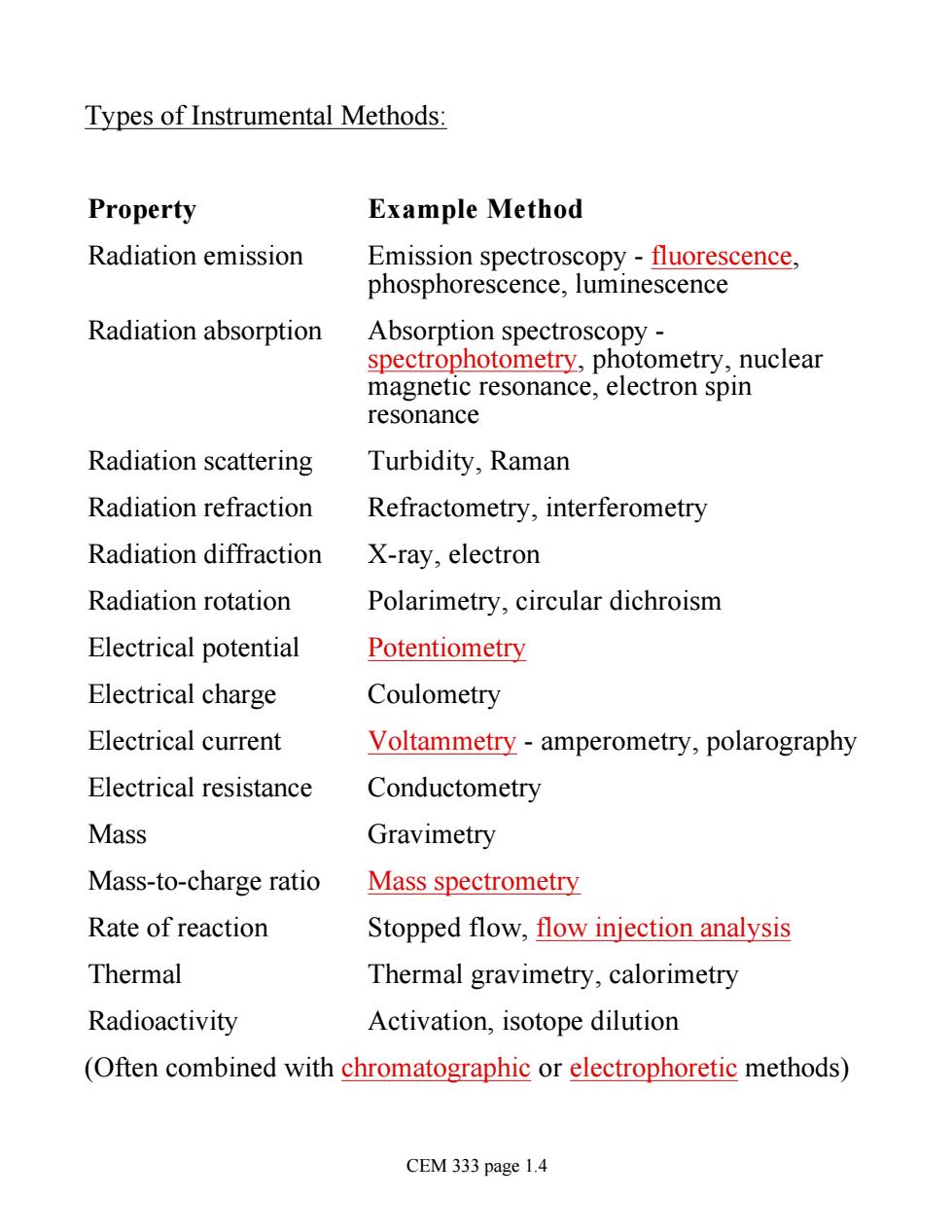
Types of Instrumental Methods: Property Example Method Radiation emission Emission spectroscopy -fluorescence, phosphorescence,luminescence Radiation absorption Absorption spectroscopy spectrophotometry,photometry,nuclear magnetic resonance,electron spin resonance Radiation scattering Turbidity,Raman Radiation refraction Refractometry,interferometry Radiation diffraction X-ray,electron Radiation rotation Polarimetry,circular dichroism Electrical potential Potentiometry Electrical charge Coulometry Electrical current Voltammetry-amperometry,polarography Electrical resistance Conductometry Mass Gravimetry Mass-to-charge ratio Mass spectrometry Rate of reaction Stopped flow,flow injection analysis Thermal Thermal gravimetry,calorimetry Radioactivity Activation,isotope dilution (Often combined with chromatographic or electrophoretic methods) CEM 333 page 1.4
Types of Instrumental Methods: Property Example Method Radiation emission Emission spectroscopy - fluorescence, phosphorescence, luminescence Radiation absorption Absorption spectroscopy - spectrophotometry, photometry, nuclear magnetic resonance, electron spin resonance Radiation scattering Turbidity, Raman Radiation refraction Refractometry, interferometry Radiation diffraction X-ray, electron Radiation rotation Polarimetry, circular dichroism Electrical potential Potentiometry Electrical charge Coulometry Electrical current Voltammetry - amperometry, polarography Electrical resistance Conductometry Mass Gravimetry Mass-to-charge ratio Mass spectrometry Rate of reaction Stopped flow, flow injection analysis Thermal Thermal gravimetry, calorimetry Radioactivity Activation, isotope dilution (Often combined with chromatographic or electrophoretic methods) CEM 333 page 1.4
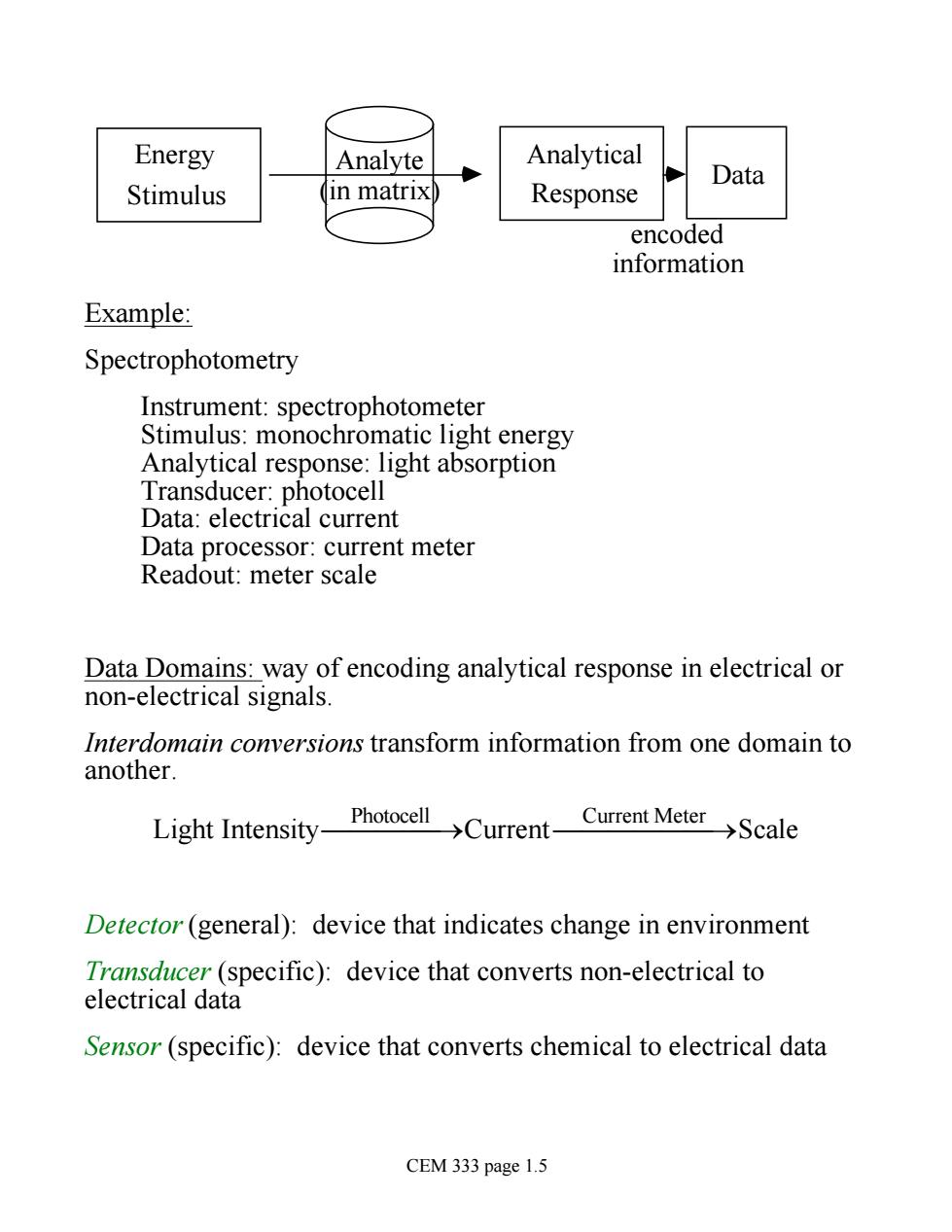
Energy Analyte Analytical Data Stimulus in matrix) Response encoded information Example: Spectrophotometry Instrument:spectrophotometer Stimulus:monochromatic light energy Analytical response:light absorption Transducer:photocell Data:electrical current Data processor:current meter Readout:meter scale Data Domains:way of encoding analytical response in electrical or non-electrical signals. Interdomain conversions transform information from one domain to another. Light Intensity-Photocell >Current Current Metercae Detector(general):device that indicates change in environment Transducer (specific):device that converts non-electrical to electrical data Sensor(specific):device that converts chemical to electrical data CEM 333 page 1.5
Stimulus Response Analyte (in matrix) Energy Analytical Data encoded information Example: Spectrophotometry Instrument: spectrophotometer Stimulus: monochromatic light energy Analytical response: light absorption Transducer: photocell Data: electrical current Data processor: current meter Readout: meter scale Data Domains: way of encoding analytical response in electrical or non-electrical signals. Interdomain conversions transform information from one domain to another. Light Intensity Photocell ¾ ¾ ¾ ¾ ¾ ® Current Current Meter ¾ ¾ ¾ ¾ ¾ ¾ ® Scale Detector (general): device that indicates change in environment Transducer (specific): device that converts non-electrical to electrical data Sensor (specific): device that converts chemical to electrical data CEM 333 page 1.5